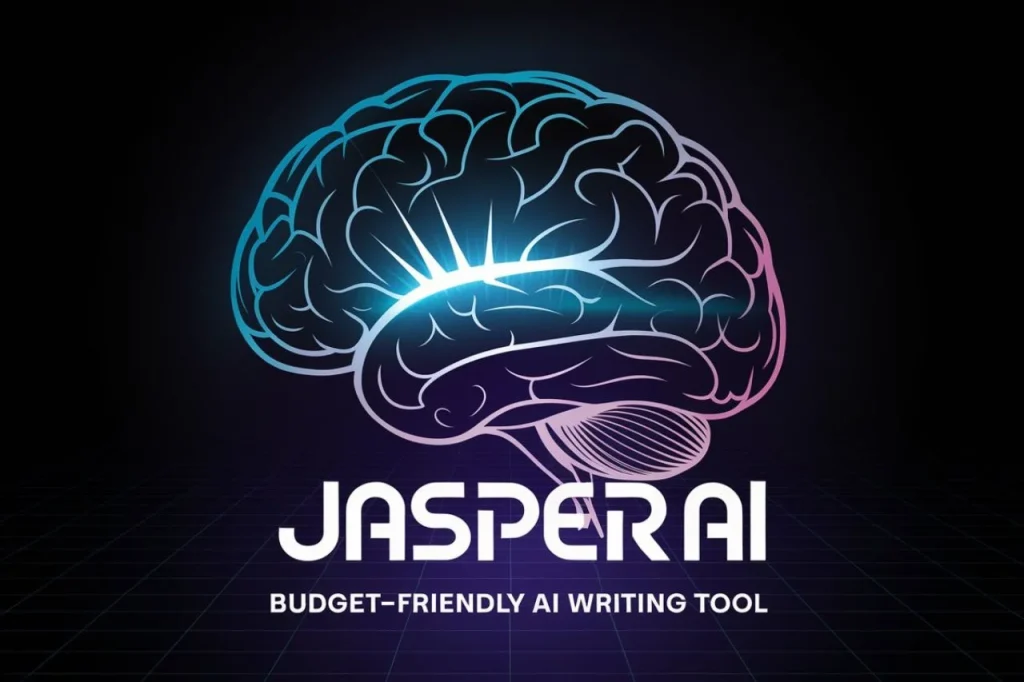
Discover the top 10 tree map AI tool options transforming data visualization in 2025! From powerful features to user-friendly designs, find the perfect tool for smarter insights. Click to explore expert reviews and comparisons.
Introduction
Data visualization has become an essential part of understanding and analyzing complex information in today’s fast-paced digital world. A Tree Map AI Tool is one of the most innovative solutions designed to make this process seamless and efficient.
Table of Contents
1. What is a Tree Map AI Tool?
A Tree Map AI Tool is an advanced software application powered by artificial intelligence that helps visualize data hierarchically. It organizes information into a tree-like structure where:
- Rectangles represent data categories: The size of each rectangle indicates the proportion of its value.
- Color-coding highlights key insights: Different colors distinguish categories, making patterns easier to spot.
Key Characteristics:
- Interactive Visualization: Allows users to drill down into details with a click.
- AI-Powered Clustering: Automatically organizes data based on patterns.
- Scalable: Handles small datasets to massive enterprise-level information.
2. Why is Visualizing Data with AI Tools Important?
AI tools like the Tree Map simplify the process of understanding complex datasets. Here’s why they are crucial:
2.1 Simplify Complexity:
- They convert raw data into visually appealing formats.
- Makes it easy to interpret patterns, trends, and outliers.
2.2 Save Time:
- Automation reduces hours of manual work.
- Provides quick insights for faster decision-making.
2.3 Drive Better Decisions:
- Clear visuals help stakeholders grasp insights effectively.
- Supports data-backed strategies in real-time.
3. Why Should You Use a Tree Map AI Tool?
Tree Map AI Tools offer a range of benefits for individuals, businesses, and researchers:
3.1 For Individuals:
- Personal Productivity: Use it to track personal budgets or projects.
- Skill Development: Learn data analysis with simple tools.
3.2 For Businesses:
- Market Analysis: Identify trends and customer preferences.
- Performance Monitoring: Visualize team outputs, sales, or inventory.
3.3 For Researchers:
- Data Representation: Simplify academic datasets for presentations.
- Trend Analysis: Spot meaningful correlations in research data.
A Tree Map AI Tool is more than just a data visualization platform. It’s a powerful ally for anyone looking to make sense of complex data quickly and efficiently. Whether you’re a business owner, a student, or a data enthusiast, this tool can transform the way you interact with information.
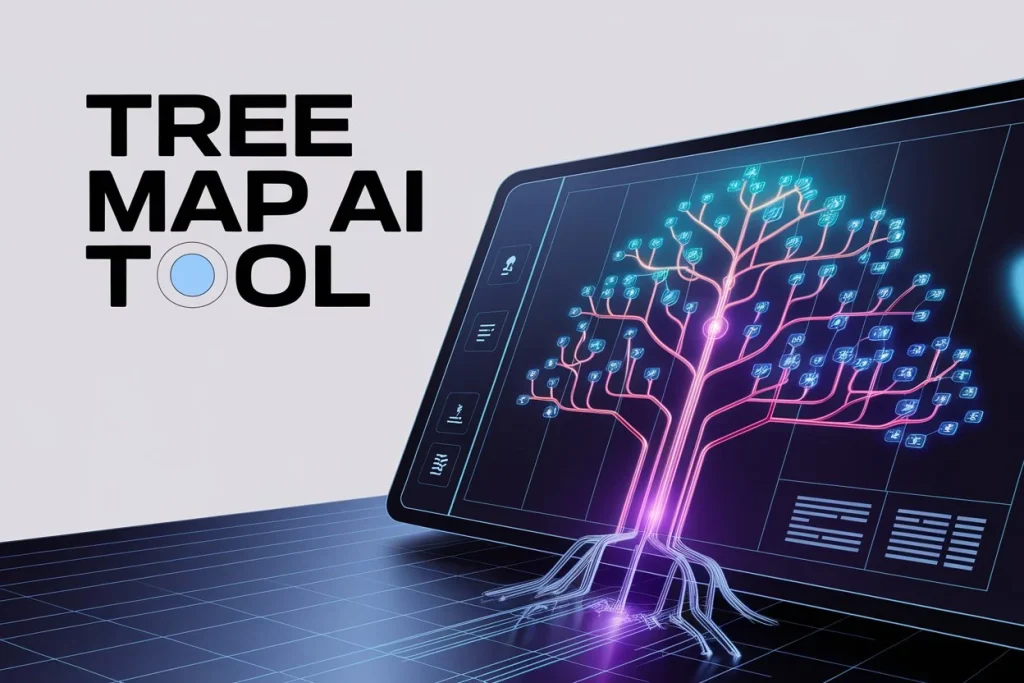
Key Features of a Tree Map AI Tool
A Tree Map AI Tool stands out because of its advanced features designed to make data visualization intuitive and impactful. Let’s dive into the key features that make this tool indispensable for various applications.
1. Data Visualization
Tree Map AI Tools excel at transforming raw data into easily digestible visuals.
How It Works:
- Data Representation: Converts complex datasets into tree-like structures with rectangles representing data points.
- Hierarchical Organization: Categorizes data in layers for better clarity.
- Dynamic Updates: Automatically adjusts visuals as new data is added.
Use Cases Across Industries:
- Business: Visualize sales performance and market trends.
- Education: Simplify learning materials and academic data.
- Healthcare: Represent patient statistics or medical research outcomes.
- Finance: Analyze budgets, expenses, or investment portfolios.
2. Customization Options
Tree Map AI Tools offer extensive customization options to ensure the visuals align with user needs.
Key Customization Features:
- Color Coding:
- Assign specific colors to data categories for easy differentiation.
- Highlight important trends or anomalies.
- Adjustable Sizing:
- Resize rectangles to reflect data importance or volume.
- Ensure proportional representation for better understanding.
- Interactive Designs:
- Enable users to zoom in, filter, or drill down for detailed insights.
- Allow real-time editing to match evolving needs.
Benefits of Customization:
- Makes visuals more engaging and user-friendly.
- Enhances focus on key data points.
3. AI-Powered Insights
Tree Map AI Tools leverage artificial intelligence to provide deeper insights.
How AI Enhances Analysis:
- Automated Data Clustering:
- Groups related data automatically based on patterns.
- Saves time by eliminating manual categorization.
- Pattern Recognition:
- Identifies trends, correlations, and anomalies in seconds.
- Highlights hidden insights that might otherwise go unnoticed.
- Predictive Analytics:
- Some tools offer forecasts and data predictions using AI algorithms.
Advantages of AI Integration:
- Delivers faster, more accurate insights.
- Reduces human error in data analysis.
The combination of advanced data visualization, customizable options, and AI-powered insights makes a Tree Map AI Tool a must-have for professionals across industries. These tools not only simplify data representation but also empower users to make informed decisions quickly and efficiently.
Benefits of Using a Tree Map AI Tool
Tree Map AI Tools provide powerful advantages that streamline data analysis and decision-making. Here are the key benefits you can expect from using these tools:
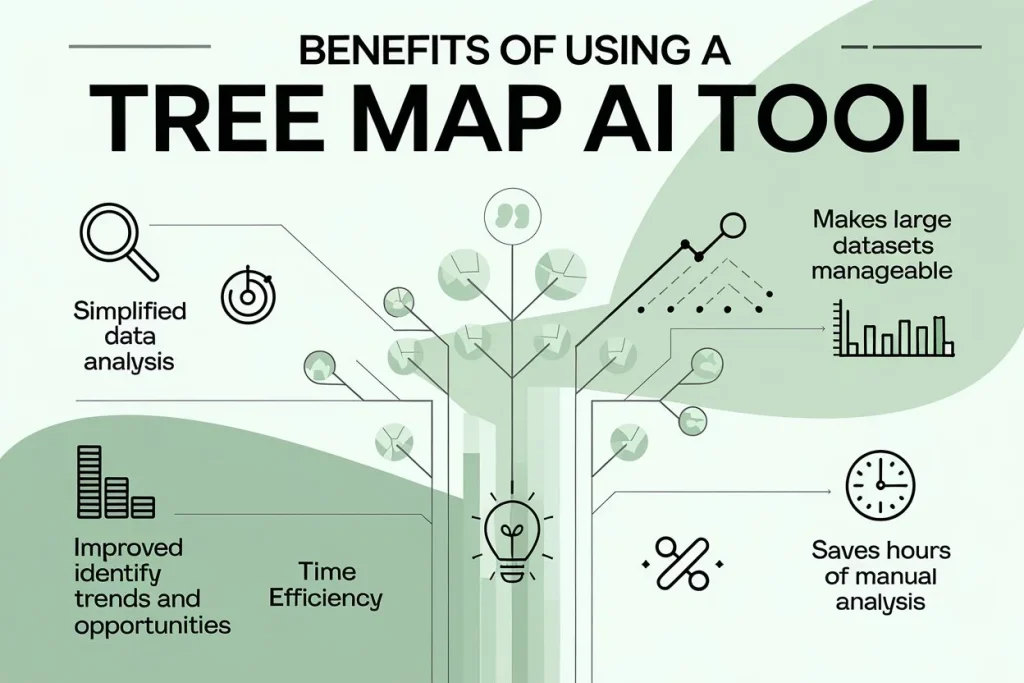
1. Simplified Data Analysis
One of the most significant advantages of Tree Map AI Tools is their ability to simplify large and complex datasets.
How It Simplifies Data:
- Data Breakdown:
- Converts huge datasets into easy-to-understand, interactive visuals.
- Displays hierarchical data structures for better clarity.
- Intuitive Design:
- Organizes data into a tree-like format, allowing users to see the relationships between different data points.
- Quick Insights:
- Instantly highlights the most significant data, helping users focus on key metrics.
Why It Matters:
- Makes large datasets manageable and accessible.
- Helps users quickly grasp the main points without getting lost in details.
2. Improved Decision-Making
Tree Map AI Tools can significantly improve the quality of decision-making by offering clear, actionable insights.
How It Enhances Decisions:
- Identifying Trends:
- Automatically detects patterns and correlations in data.
- Helps users spot emerging trends or issues.
- Visualizing Opportunities:
- Highlights areas with high potential for growth or improvement.
- Makes it easier to assess areas of strength and weakness.
- Real-Time Analysis:
- Provides up-to-date visuals for timely decision-making.
Why It Matters:
- Helps businesses, individuals, and researchers make more informed, data-driven decisions.
- Reduces guesswork and enables smarter strategies.
3. Time Efficiency
Using a Tree Map AI Tool can save you significant time compared to traditional methods of data analysis.
How It Saves Time:
- Automation:
- AI automatically organizes, clusters, and analyzes data, eliminating manual effort.
- Quick Visualization:
- Instantly generates interactive, easy-to-understand visualizations.
- No Need for Complex Analysis:
- No need to sift through numbers and spreadsheets manually—data is ready to use right away.
Why It Matters:
- Saves hours of manual analysis and data cleaning.
- Allows users to focus on higher-level tasks like strategy and decision-making.
Tree Map AI Tools offer clear benefits by simplifying data analysis, enhancing decision-making, and saving valuable time. Whether you’re dealing with large datasets, making crucial business decisions, or simply looking to save time, these tools provide efficient solutions to meet your needs.
How to Choose the Right Tree Map AI Tool
Choosing the right Tree Map AI Tool can be a game-changer for how you visualize and analyze your data. With so many options available, it’s important to evaluate certain factors to ensure you pick the tool that best suits your needs. Here are the key aspects to consider:
1. Key Factors to Consider
1.1 Ease of Use
The user-friendliness of a tool is crucial, especially if you’re new to data visualization or AI tools. Look for tools with a simple, intuitive interface that doesn’t require advanced technical knowledge.
What to Look For:
- User-Friendly Design: Tools with drag-and-drop features or preset templates are easier to use.
- Clear Navigation: A simple dashboard that helps you quickly access the features you need.
- Quick Learning Curve: Easy-to-understand guides or tutorials to get you started.
Why It Matters:
- A tool that’s easy to use saves you time and reduces frustration.
- Helps you focus on the data, not on learning complex software.
1.2 Features and Functionalities
Different Tree Map AI Tools offer various features. Make sure the tool you choose has the functionalities that align with your needs.
What to Look For:
- Customization Options: The ability to change colors, sizes, and interactivity of the tree map.
- Data Import Flexibility: Check if the tool supports a variety of data formats (CSV, Excel, etc.).
- Advanced Analysis Tools: Features like AI-powered clustering, predictive analytics, and pattern recognition can add value.
Why It Matters:
- The more features a tool has, the more flexibility it offers for your data analysis.
- Choose a tool that aligns with your specific use case, whether it’s for business, research, or personal projects.
1.3 Integration with Other Software/Tools
You may need to integrate your Tree Map AI Tool with other software for data import/export, analysis, or reporting.
What to Look For:
- Seamless Integrations: Ensure the tool works with popular data platforms like Google Sheets, Excel, or CRM systems.
- API Access: If you want more advanced integrations or customization, look for tools that offer API access.
- Third-Party App Support: Some tools can sync with other data visualization or reporting tools, giving you greater flexibility.
Why It Matters:
- Integration with other tools saves time and increases efficiency by automating workflows.
- Makes it easier to work within your existing ecosystem, without needing to switch between multiple platforms.
2. Pricing and Support
2.1 Free vs. Paid Versions
Many Tree Map AI Tools offer both free and paid versions. It’s important to know which features are available in each to decide what’s right for you.
What to Look For:
- Free Version: Some tools offer basic functionalities for free, ideal for beginners or those with simple needs.
- Paid Version: The paid versions often unlock more advanced features, such as AI-powered insights, extra customization, or larger data capacity.
- Free Trials: Many paid tools offer free trials, which allow you to test the premium features before committing.
Why It Matters:
- The free version can help you get started without committing to a subscription, but you may need a paid version as your needs grow.
- Paid versions often offer more powerful features, which could be beneficial for businesses or advanced use cases.
2.2 Customer Support and Community Forums
Good customer support and an active community are vital, especially if you encounter technical issues or need help getting started.
What to Look For:
- Responsive Support Team: Make sure the tool offers responsive customer service via chat, email, or phone.
- Comprehensive Help Center: Look for a well-organized support section with FAQs, guides, and video tutorials.
- Active Community Forums: Check if there’s an active user community where you can share experiences and tips.
Why It Matters:
- Having reliable support ensures you don’t get stuck during the learning process or when using advanced features.
- A strong community provides additional resources, like tips, tricks, and use case ideas, which can be invaluable.
Choosing the right Tree Map AI Tool requires considering factors such as ease of use, features, integration capabilities, pricing, and support options. By evaluating these aspects carefully, you can select a tool that suits your specific needs and helps you make the most out of your data analysis efforts.
Top 10 Tree Map AI Tools in 2025
When it comes to choosing a Tree Map AI Tool, there are many options available. Below is a brief comparison of the top 10 tools in 2025, highlighting their features, pros, and cons to help you make an informed decision.
1. Tool 1: Tableau
Website: Tableau
Features:
- Interactive and customizable tree maps.
- Supports a wide variety of data sources (Excel, Google Sheets, SQL).
- AI-driven recommendations for better data insights.
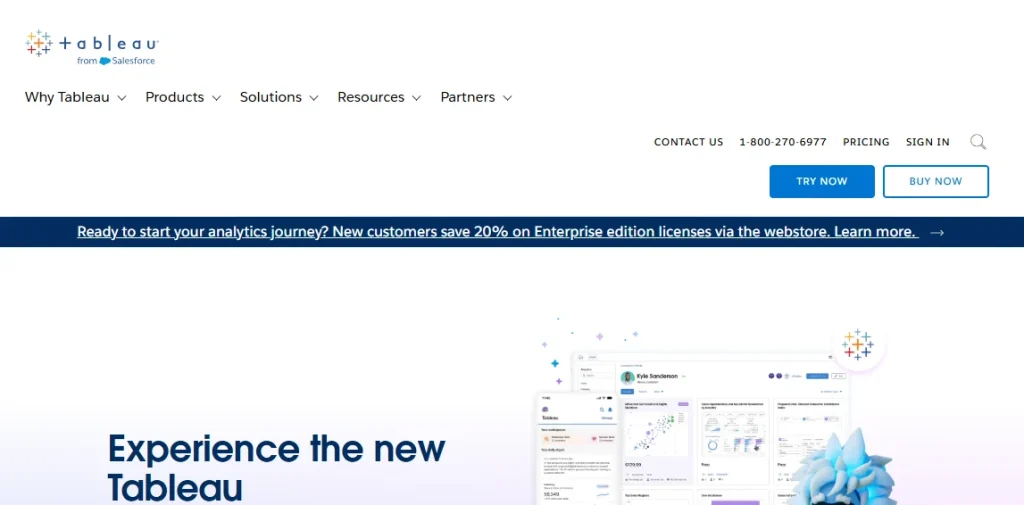
Screen shot from Tableau
Pros:
- User-friendly with drag-and-drop functionality.
- Excellent customer support and a large community.
- Advanced analytics and real-time data processing.
Cons:
- Higher price point for the full suite of features.
- Steeper learning curve for beginners.
2. Tool 2: Power BI
Website: Power BI
Features:
- Easy integration with Microsoft Office tools like Excel and SharePoint.
- Customizable and interactive tree maps for better data insights.
- Strong AI capabilities for data clustering and prediction.
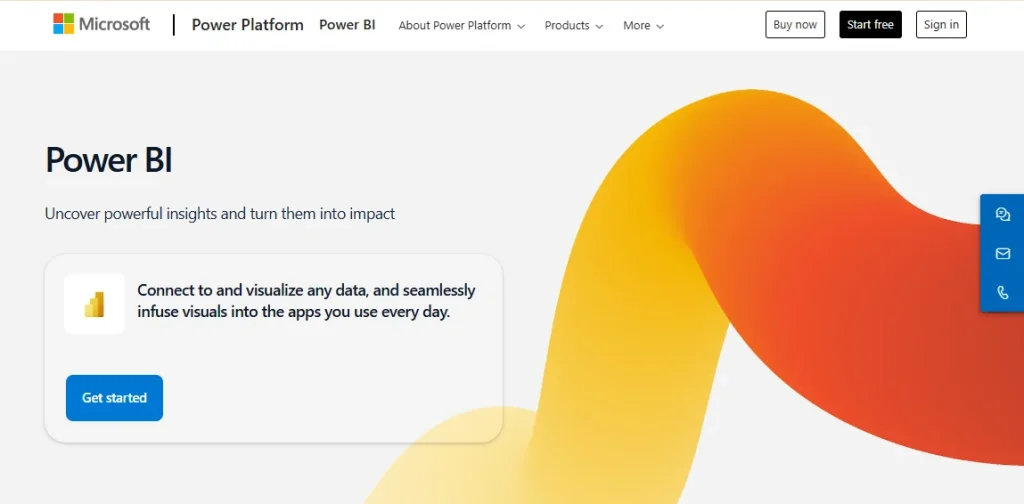
Screen shot from Power BI
Pros:
- Affordable pricing, especially for businesses using Microsoft tools.
- Great for real-time reporting and dashboarding.
- Excellent support and training resources.
Cons:
- Limited to Microsoft ecosystem; not ideal for non-Microsoft users.
- Can be slower with very large datasets.
3. Tool 3: Qlik Sense
Website: Qlik Sense
Features:
- Powerful AI-driven analytics and clustering.
- Highly interactive and customizable visualizations.
- Cloud-based and offers integration with a variety of data sources.
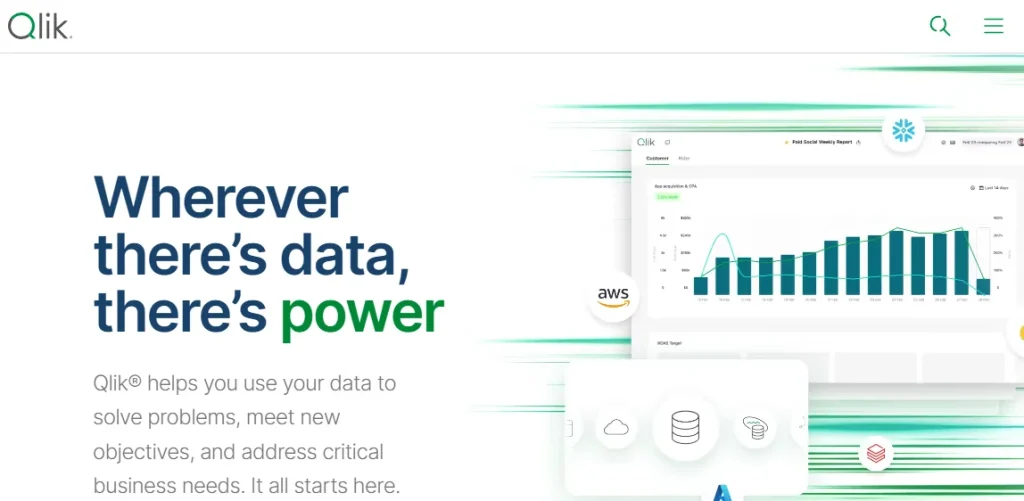
Screen Shot from Qlik Sense
Pros:
- Easy data preparation and loading.
- Strong security and scalability for businesses.
- Good for creating detailed, real-time dashboards.
Cons:
- The interface can be complex for beginners.
- More expensive compared to other tools.
4. Tool 4: Sisense
Website: Sisense
Features:
- Robust analytics and AI-powered insights.
- Tree maps with real-time data visualization.
- Offers embedding capabilities for custom applications.
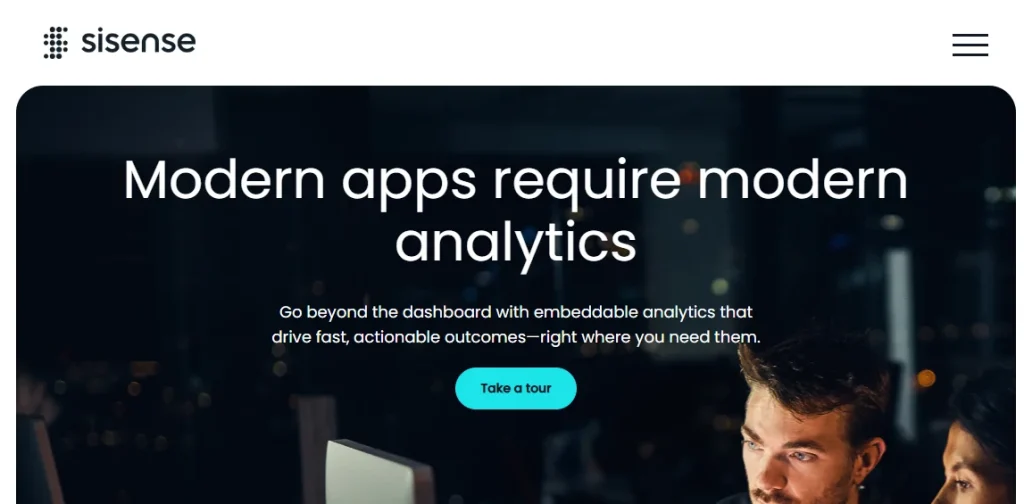
Screen Shot from Sisense
Pros:
- User-friendly interface and powerful integrations.
- Great for large datasets and cloud-based solutions.
- Customizable dashboards and reports.
Cons:
- Pricing may be prohibitive for smaller businesses.
- Learning curve for advanced features.
5. Tool 5: Infogram
Website: Infogram
Features:
- Easy-to-use, with drag-and-drop tree map creation.
- Pre-built templates and customization options.
- AI tools for automatically generating insights.
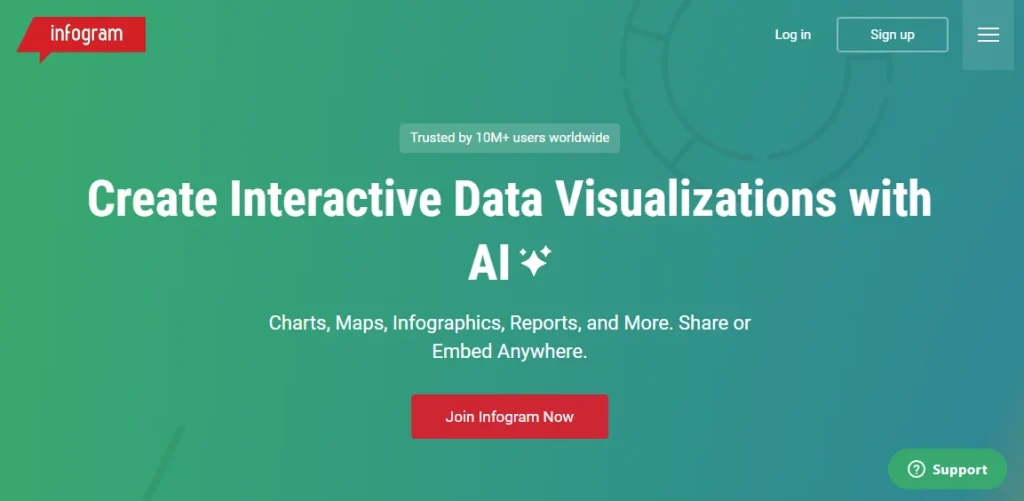
Screen shot from infogram
Pros:
- Affordable pricing plans.
- Quick setup and easy-to-use interface.
- Perfect for beginners and non-technical users.
Cons:
- Limited advanced analytics features.
- Not suitable for very large datasets.
6. Tool 6: Google Data Studio
Website: Google Data Studio
Features:
- Free tool with Google integration for quick data visualization.
- Allows customization of tree maps with simple tools.
- AI-driven data insights and recommendations.
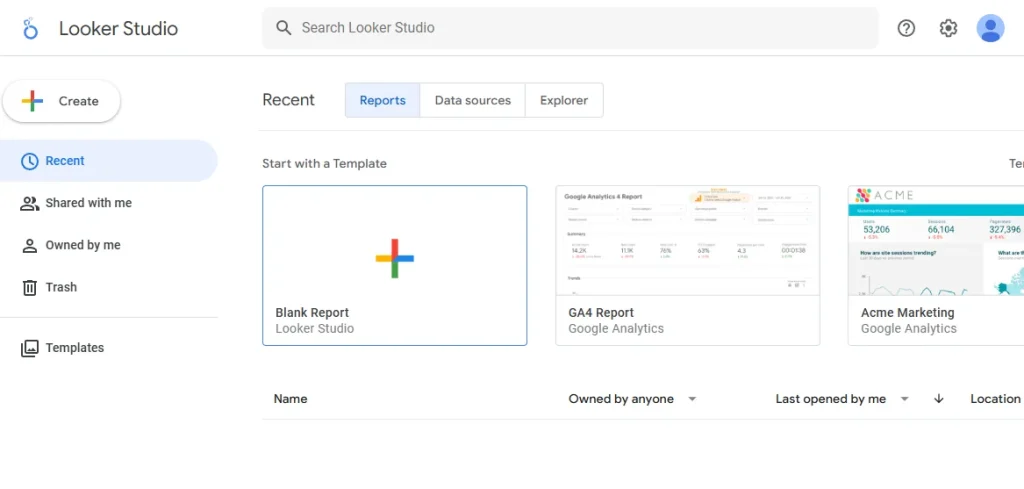
Screen Shot from Google Data studio
Pros:
- Completely free with strong integration across Google tools.
- Great for businesses using Google Analytics and other Google products.
- User-friendly and customizable for all experience levels.
Cons:
- Lacks advanced AI features compared to paid options.
- May have limitations for complex data processing.
7. Tool 7: D3.js
Website: D3.js
Features:
- Open-source JavaScript library for creating custom tree maps.
- Full control over design and interactivity.
- Flexible integration with other data tools.
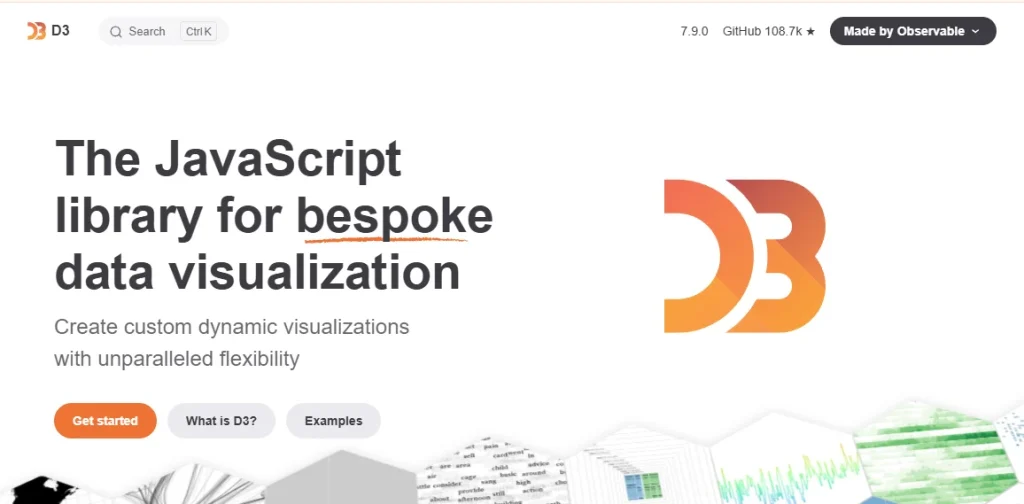
Screen shot from D3
Pros:
- Highly customizable and flexible for developers.
- Free to use with no licensing fees.
- Can handle large datasets and complex visualizations.
Cons:
- Requires coding knowledge to get started.
- Not ideal for beginners or non-technical users.
8. Tool 8: Lucidchart
Website: Lucidchart
Features:
- Drag-and-drop interface for creating easy-to-understand tree maps.
- Offers collaborative features for team data analysis.
- Provides AI-driven templates for faster creation.
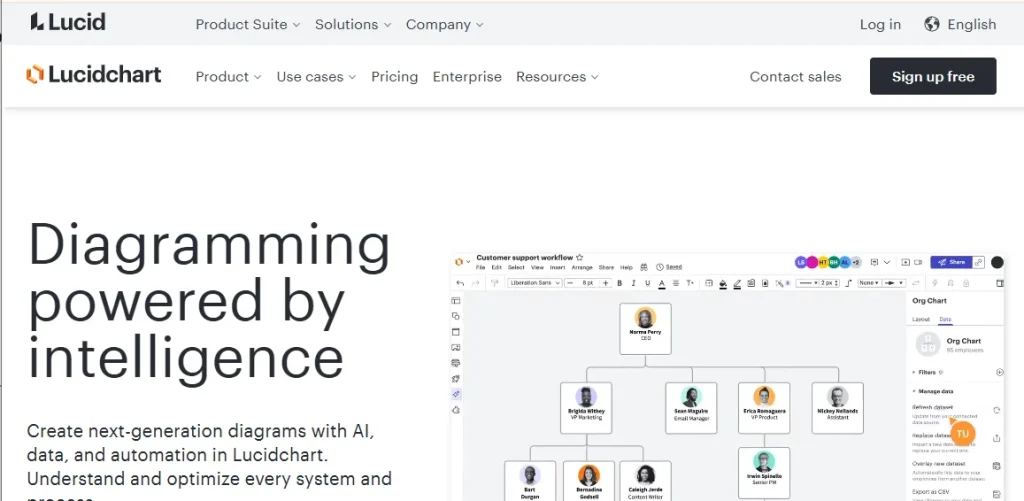
Screen shot from Lucidchart
Pros:
- Ideal for teams due to its collaboration features.
- Easy to use with a variety of templates.
- Affordable pricing for small businesses.
Cons:
- Lacks deep analytical capabilities.
- Limited tree map customization compared to other tools.
9. Tool 9: Zoho Analytics
Website: Zoho Analytics
Features:
- Offers powerful AI-based data visualization tools.
- Includes customizable tree maps for dynamic data representation.
- Integration with various data sources like Google Analytics, Salesforce, and more.
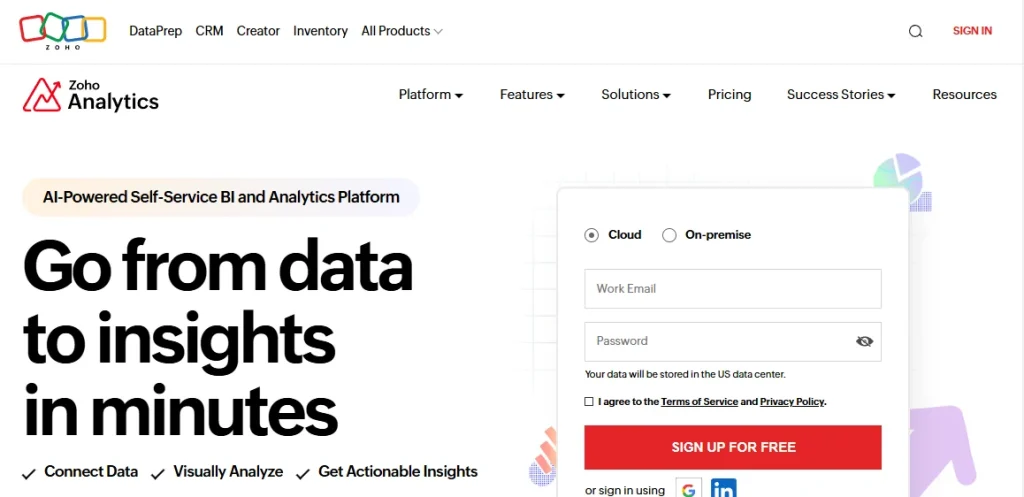
Screen shot from Zoho Analytics
Pros:
- Affordable pricing with a free plan available.
- Strong integration capabilities for seamless workflows.
- Great for businesses of all sizes.
Cons:
- Can be overwhelming for beginners due to the number of features.
- Limited customization for tree map visuals.
10. Tool 10: Minitab
Website: Minitab
Features:
- Comprehensive statistical analysis and tree map capabilities.
- AI-powered tools for data clustering and trend analysis.
- Integration with multiple data sources and reporting tools.
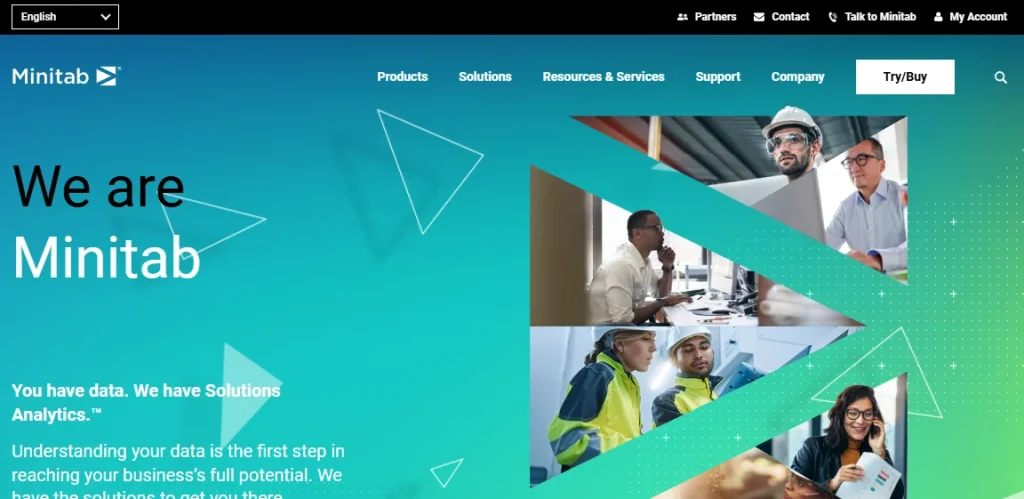
Screen shot from minitab
Pros:
- Excellent for detailed statistical analysis and predictive modeling.
- Trusted by industries like manufacturing and healthcare.
- Strong customer support and training options.
Cons:
- Higher cost, particularly for small businesses or individual users.
- May be more complex than needed for simple data visualization tasks.
Choosing the right Tree Map AI Tool depends on your specific needs, budget, and level of expertise. Whether you’re a beginner looking for a simple tool like Infogram or an advanced user seeking deeper insights with Tableau, there’s a solution for every need. Explore the options above, compare the features and pricing, and select the one that best fits your data visualization goals.
Comparison Table: Top 10 Tree Map AI Tools in 2025
Here’s a quick comparison table to help you evaluate the top 10 Tree Map AI Tools based on their features, pricing model, and support options:
| Tool | Key Features | Pricing Model | Best For | Website |
|---|---|---|---|---|
| Tableau | Interactive tree maps, AI-driven insights, real-time data processing | Subscription-based (offers free trial) | Businesses and advanced data analysts | Tableau |
| Power BI | Customizable tree maps, AI insights, strong Microsoft integration | Free (with limited features), Subscription-based for full features | Microsoft users and small businesses | Power BI |
| Qlik Sense | AI clustering, cloud-based, interactive visuals | Subscription-based, with free trial option | Medium to large businesses and enterprises | Qlik Sense |
| Sisense | Cloud-based, real-time data visualizations, robust analytics | Custom pricing (contact for details) | Large enterprises, cloud solutions | Sisense |
| Infogram | Easy-to-use, drag-and-drop interface, pre-built templates | Offers free plan with paid subscription options | Beginners and small businesses | Infogram |
| Google Data Studio | Google integration, free tool, customizable visualizations | Free | Google users, small businesses, personal projects | Google Data Studio |
| D3.js | Open-source, flexible, highly customizable, large dataset support | Free | Developers, advanced users | D3.js |
| Lucidchart | Drag-and-drop, collaborative, easy-to-understand visuals | Free plan with premium paid options | Teams and businesses requiring collaboration | Lucidchart |
| Zoho Analytics | AI-based insights, customizable, integrates with multiple sources | Offers free plan with paid subscription options | Small to medium businesses | Zoho Analytics |
| Minitab | Statistical analysis, AI-driven insights, trend analysis | Subscription-based (contact for pricing) | Industries requiring deep statistical analysis | Minitab |
Summary
This table offers a comprehensive overview of the top Tree Map AI Tools in 2025, with details on their key features, pricing models, and best-use cases. For most tools, a free plan or trial version is available to help you get started, with paid subscriptions unlocking additional features. Whether you’re looking for advanced AI features with Tableau or a budget-friendly option like Google Data Studio, you’ll find an option that meets your needs.
Step-by-Step Guide: How to Use a Tree Map AI Tool
Using a Tree Map AI Tool is an efficient way to visualize complex data and make insightful decisions. Below is a simple, step-by-step guide to help you get started and make the most out of your Tree Map AI Tool.
Step 1: Importing Your Dataset
The first step in creating a tree map is importing the data you want to visualize. Most Tree Map AI tools support various data formats, such as CSV, Excel, or direct integration with other tools like Google Sheets.
How to Import Your Data:
- Open the Tool: Launch your Tree Map AI Tool and find the “Import” or “Upload” button.
- Select Your File: Choose the file from your device or cloud storage (depending on the tool’s integration capabilities).
- Verify Data: Ensure your data is properly formatted (e.g., columns for categories and values).
Why It Matters:
- Importing your data correctly ensures that the visualization will be accurate and meaningful.
- Some tools may allow for live data syncing, so make sure the import process is seamless.
Step 2: Customizing the Tree Map Layout
Once your dataset is uploaded, it’s time to customize your tree map layout. This is where you can adjust how the data is displayed to make it more intuitive and useful for analysis.
How to Customize:
- Choose a Layout: Select the layout style (rectangular, circular, etc.) that best suits your data.
- Adjust Colors: Use color coding to highlight categories or values. For example, higher values can be shaded darker to make them stand out.
- Set Data Variables: Choose which variables (e.g., category, size, color) will be represented on the tree map. This will help the AI tool map the data accordingly.
- Interactive Features: Enable interactivity, such as tooltips or clickable elements, to explore the data more deeply.
Why It Matters:
- Customizing the layout makes your tree map easier to understand and visually appealing.
- You can highlight key trends and insights, making it easier for users to spot patterns.
Step 3: Analyzing and Interpreting the Visualization
Now that your tree map is ready, it’s time to analyze the data. Tree maps are designed to help you spot trends, identify outliers, and understand the relationships between different data points.
How to Analyze:
- Look for Patterns: Identify clusters, large segments, or outliers that stand out based on your customization (such as color or size).
- Focus on Key Insights: Analyze the most important sections that could indicate significant changes or areas for improvement.
- Use AI Insights: Many Tree Map AI tools provide AI-driven insights, such as automatic clustering or pattern recognition, to help guide your analysis.
Why It Matters:
- Properly analyzing the tree map helps you draw actionable insights and make informed decisions.
- AI features can make the analysis faster and more accurate, saving you time on manual interpretation.
Step 4: Exporting or Sharing Your Results
Once you’ve analyzed the data and are ready to share your findings, the final step is to export or share the tree map. Many tools allow you to export your work into different formats or share it with team members or clients.
How to Export or Share:
- Export the File: Most tools allow you to export your tree map as an image (PNG, JPG), PDF, or interactive HTML file. Choose the format that best fits your needs.
- Share Directly: You can also share the visualization directly from the tool to team members or clients via a link or integrated sharing options (e.g., Google Drive, email).
- Embed on Websites: Some tools allow you to embed interactive tree maps directly into websites or dashboards for public access.
Why It Matters:
- Exporting or sharing your results makes it easy to collaborate with others and communicate your findings.
- Interactive sharing options can provide an engaging experience for viewers, allowing them to explore the data themselves.
Following these simple steps will help you efficiently use any Tree Map AI Tool to visualize, analyze, and share your data. Whether you are a business owner, researcher, or data enthusiast, these tools can make your data analysis process much more efficient and insightful. By customizing your layout, leveraging AI features, and sharing your results, you can turn complex data into clear, actionable insights.
Real-Life Use Cases of Tree Map AI Tools
Tree Map AI Tools have a wide range of applications across various industries. These tools help organizations and individuals better understand complex datasets by converting them into clear, visually engaging formats. Below are some real-life use cases for Tree Map AI Tools:
1. Business Applications:
Sales Data Analysis:
- How It Helps: Tree maps allow businesses to visualize sales data, helping to identify high-performing products, regions, or salespeople.
- Example: A retail company can use a tree map to display sales performance by product category, helping decision-makers quickly see which products are driving revenue and which need attention.
Customer Segmentation:
- How It Helps: Tree maps can help businesses segment their customers based on demographics, purchasing behavior, or other criteria.
- Example: A marketing team could use a tree map to categorize customers by region, spending habits, or age group to target personalized promotions or campaigns.
Why It Matters:
- Using tree maps in business applications helps improve decision-making by presenting complex data in an easy-to-understand, actionable format.
- Businesses can identify trends and insights quickly, enabling more effective strategies and growth.
2. Educational Applications:
Simplifying Complex Topics for Students:
- How It Helps: Tree maps can simplify complex subjects by breaking them down into smaller, digestible parts. They can visualize relationships between concepts, making learning easier.
- Example: In a history class, a teacher could use a tree map to show the relationships between historical events, timelines, and key figures. This visual representation helps students grasp connections more clearly.
Interactive Learning Tools:
- How It Helps: Tree maps can be used interactively in classrooms, allowing students to explore different categories, subcategories, and their relationships.
- Example: In a science class, students can use a tree map to explore different ecosystems, their components, and how species within those ecosystems interact.
Why It Matters:
- Tree maps make it easier for students to absorb and retain complex information.
- Visualizing complex topics enhances understanding and engagement in the classroom, making learning more effective.
3. Healthcare Applications:
Visualizing Patient Data for Better Diagnostics:
- How It Helps: In healthcare, tree maps can be used to visualize patient data, such as medical history, lab results, and diagnostic information.
- Example: A doctor can use a tree map to see patterns in a patient’s health data, such as tracking the frequency of medical conditions, test results, and treatments over time.
Disease Pattern Recognition:
- How It Helps: Tree maps can help healthcare professionals visualize patterns in patient data related to diseases, enabling early detection and personalized treatments.
- Example: In epidemiology, a health organization might use tree maps to track the spread of a disease in different regions, helping them identify hotspots and allocate resources efficiently.
Why It Matters:
- In healthcare, tree maps make it easier for doctors, researchers, and healthcare providers to quickly identify trends in patient data, improving diagnostics and treatment plans.
- They also allow for more effective resource allocation and decision-making, which can save lives and reduce costs.
Tree Map AI Tools offer versatile applications in various fields, from business and education to healthcare. By transforming complex datasets into easy-to-understand visual formats, these tools provide valuable insights that help professionals make better decisions. Whether it’s for sales analysis, simplifying complex educational topics, or improving healthcare diagnostics, Tree Map AI tools are essential for anyone looking to visualize data effectively.
Tips for Maximizing Tree Map AI Tools
To get the most out of Tree Map AI Tools, it’s essential to follow best practices and avoid common mistakes. Below are some tips to help you create effective, insightful tree maps that truly make a difference in your data analysis.
1. Best Practices for Creating Effective Tree Maps
Keep It Simple:
- How to Do It: Avoid overloading your tree map with too many categories or data points. Focus on the most relevant data that will provide clear insights.
- Why It Matters: A cluttered tree map can confuse the viewer and make it difficult to extract actionable insights. A simpler map is easier to understand.
Use Clear and Consistent Color Schemes:
- How to Do It: Choose a color palette that is visually appealing and consistent across all data categories. For example, use different shades of the same color to represent data ranges.
- Why It Matters: A consistent color scheme helps users quickly identify relationships and trends in the data. It also ensures your tree map is visually appealing and easy to interpret.
Focus on the Most Important Data:
- How to Do It: Highlight key metrics, trends, or categories that are most relevant to your analysis or objectives.
- Why It Matters: Focusing on the most important data allows viewers to quickly grasp the key insights without getting lost in the details.
Ensure Interactivity:
- How to Do It: Enable interactive features like tooltips, clickable sections, and zoom options to allow users to explore the data in more depth.
- Why It Matters: Interactivity adds value to your tree map by allowing users to drill down into specific data points for a more detailed view.
Use Hierarchical Structure:
- How to Do It: Organize your data in a hierarchical structure so that categories and subcategories are easily distinguishable.
- Why It Matters: A well-organized tree map helps viewers understand the relationships between different data points and navigate through the information more easily.
2. Common Mistakes to Avoid
Overcrowding Your Tree Map:
- Mistake: Including too many categories or data points in a single tree map.
- Why It’s a Problem: Overcrowding can overwhelm the user and make it difficult to focus on the most important insights.
- Solution: Stick to the most relevant data and keep the map simple and easy to read.
Using Too Many Colors or Contrasting Colors:
- Mistake: Using too many colors or contrasting colors that are visually jarring.
- Why It’s a Problem: Excessive color use can distract from the message and make the tree map hard to interpret.
- Solution: Choose a limited and consistent color palette to maintain visual clarity and cohesion.
Ignoring Mobile or Small Screen Optimization:
- Mistake: Designing your tree map without considering mobile or smaller screens.
- Why It’s a Problem: If your tree map isn’t optimized for smaller screens, users may struggle to interact with or view the map on mobile devices.
- Solution: Ensure your tree map tool is responsive and adjusts to different screen sizes, providing an optimal viewing experience across all devices.
Neglecting Data Labeling:
- Mistake: Failing to clearly label categories and values.
- Why It’s a Problem: Without clear labels, it’s difficult for users to understand what the different sections of the tree map represent.
- Solution: Always include clear, readable labels and values, and make sure they are positioned in a way that doesn’t clutter the map.
Forgetting to Test for Usability:
- Mistake: Not testing your tree map for usability before sharing it.
- Why It’s a Problem: Without proper testing, users may encounter issues or misunderstand the map’s layout and data.
- Solution: Test your tree map with a small audience to ensure it’s easy to use and navigate, and make adjustments based on feedback.
By following these best practices and avoiding common mistakes, you can maximize the potential of Tree Map AI Tools and create visualizations that are not only aesthetically pleasing but also highly informative. A well-designed tree map will enhance your ability to analyze and share data, leading to better insights and decision-making.
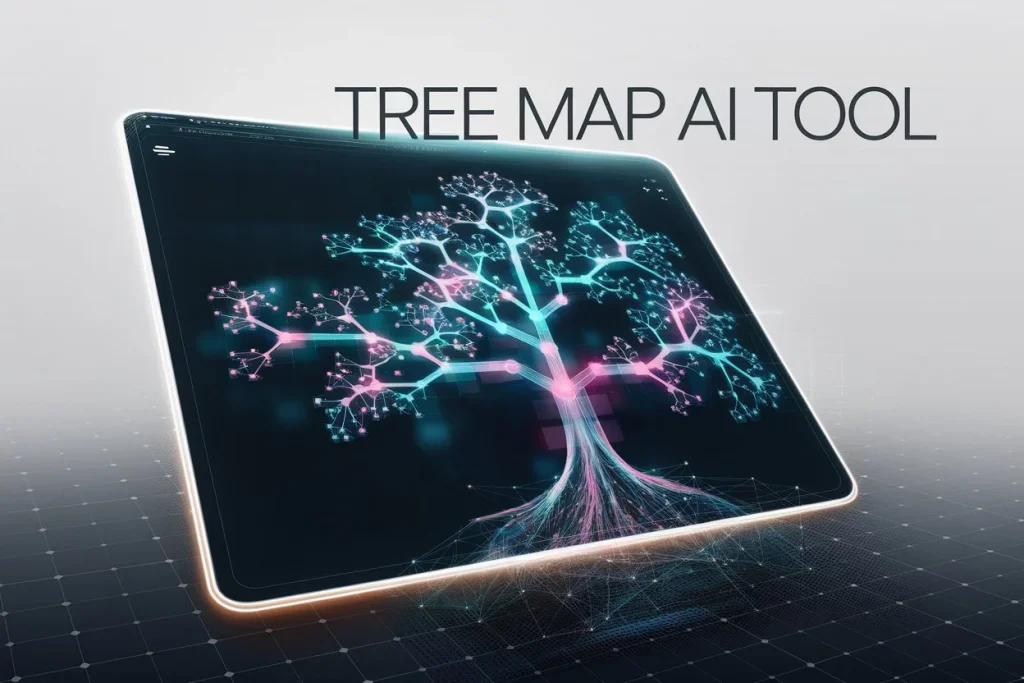
FAQs
What is a Tree Map AI Tool?
A Tree Map AI Tool is a data visualization tool that uses tree maps to display hierarchical data structures. It transforms complex datasets into easy-to-read visuals, helping users analyze patterns, relationships, and trends efficiently. These tools leverage AI to automatically identify clusters, insights, and patterns within the data.
How Does a Tree Map AI Tool Work?
A Tree Map AI Tool works by representing data in a hierarchical manner, where each “branch” or “node” of the tree represents a category, and subcategories are nested within it. The size and color of each box represent values or attributes, making it easier to analyze large datasets and identify key trends.
What Are the Key Benefits of Using a Tree Map AI Tool?
Simplified Data Analysis: Quickly visualize and understand complex data.
Improved Decision-Making: Identify trends and outliers that influence decisions.
Time Efficiency: Save hours of manual analysis by leveraging AI-driven insights.
Customizable Layouts: Tailor the visualization to your needs with color coding, interactivity, and more.
Can Tree Map AI Tools Be Used for Any Industry?
Yes! Tree Map AI Tools are versatile and can be used across various industries, including business, healthcare, education, marketing, and finance. They help users visualize complex data in an easy-to-understand format, regardless of the field.
How Do I Choose the Right Tree Map AI Tool?
When choosing a Tree Map AI Tool, consider the following:
Ease of Use: Make sure the tool has an intuitive interface.
Features and Functionalities: Look for customizable options, AI-powered insights, and integration capabilities.
Pricing: Compare free vs. paid versions to find the best fit for your budget.
Support: Check if customer support and user community forums are available.
Are There Free Tree Map AI Tools Available?
Yes, several Tree Map AI tools offer free versions with basic features. Popular free options include Google Data Studio and Infogram, which allow users to create basic tree maps and other visualizations. However, premium versions often unlock more advanced functionalities like AI insights, customization, and larger datasets.
How Can Tree Map AI Tools Improve Business Insights?
Tree Map AI Tools help businesses visualize and interpret data quickly, which can lead to better decision-making. For example, sales data can be visualized to track performance by region, product, or sales representative. This enables businesses to optimize their operations and strategies based on real-time insights.
Are Tree Map AI Tools Easy to Use for Beginners?
Yes, many Tree Map AI tools are designed with user-friendliness in mind. Tools like Infogram and Google Data Studio are particularly great for beginners due to their drag-and-drop interfaces and pre-built templates. However, more advanced tools like Tableau and Power BI may require a bit of learning.
Conclusion: Unlock the Power of Tree Map AI Tools
Tree Map AI Tools offer immense value in transforming complex datasets into clear, actionable insights. Whether you’re a business professional, educator, healthcare provider, or researcher, these tools provide powerful ways to visualize hierarchical data, identify trends, and make informed decisions.
Recap of the Benefits and Importance of Tree Map AI Tools
- Simplified Data Visualization: Tree maps make it easier to understand complex datasets by breaking them down into a visually intuitive format.
- AI-Driven Insights: These tools use AI to automatically detect patterns, clusters, and trends within your data, saving you time and effort.
- Customizable and Interactive: With customization options like color coding, sizing, and interactivity, you can tailor your tree maps to meet your specific needs.
- Versatility Across Industries: From business analytics to healthcare diagnostics, Tree Map AI tools are used in various sectors to streamline data analysis.
- Improved Decision-Making: By visualizing data effectively, these tools help you identify key trends, outliers, and opportunities, leading to better business and research decisions.
Try a Tree Map AI Tool Today!
If you’re ready to take your data visualization to the next level, now is the perfect time to try one of the top Tree Map AI tools mentioned in this guide. Whether you’re looking to enhance business insights, improve educational outcomes, or simplify complex healthcare data, these tools can make a significant difference.
Don’t wait! Start exploring and implementing Tree Map AI tools today to unlock the full potential of your data.
We’d love to hear about your experiences—feel free to share your thoughts or any questions in the comments below!
Explore More Free AI Tools
How to use perchance AI Image Generator
How to Use Pictory AI for Free
Jasper AI Best Budget-Friendly Writing Tool
Unlock Writesonic AI for Free Step-by-Step Tutorial
Free AI Tool to Create Passport Photos in Minutes with AI Ease
AI Image Generator No Restrictions Unlock Limitless Creativity
How to Use Quetext Free Plagiarism Checker Like a Pro
How to Choose the Perfect AI Tool for Law Students A Complete Guide
Unleash the Power of AI Rapper Voice Generator Today
Felo AI Tool Unlock Smarter Searches with This Revolutionary Innovation
Newsletter Signup
“Subscribe to our newsletter for weekly updates on the latest AI tools, tips, and trends to boost your skills!”



